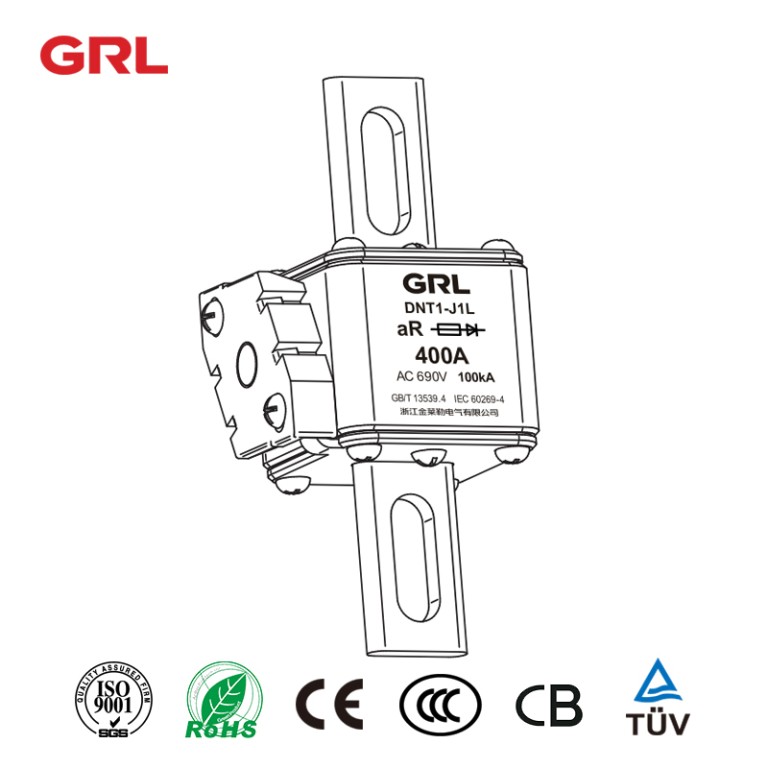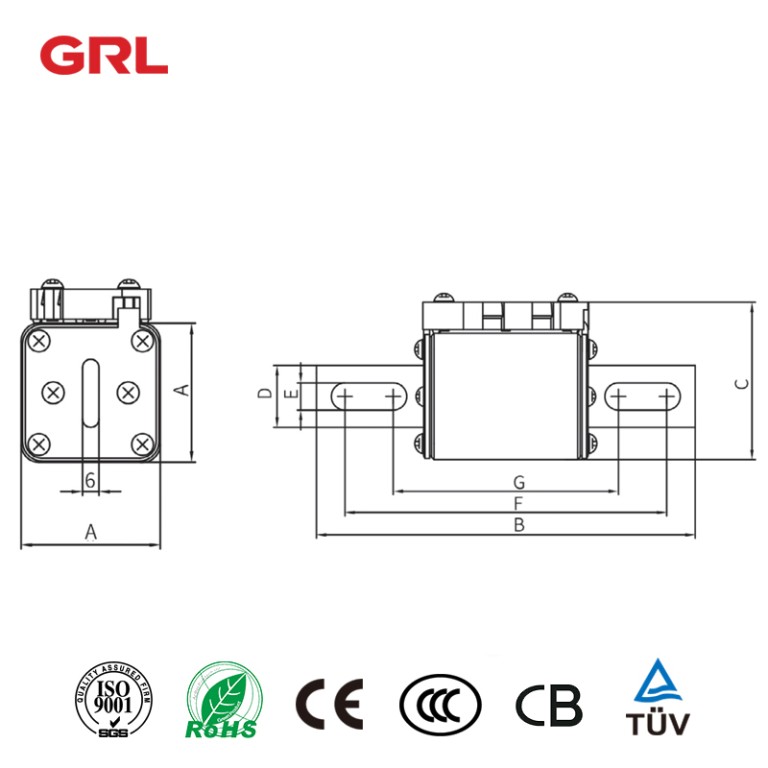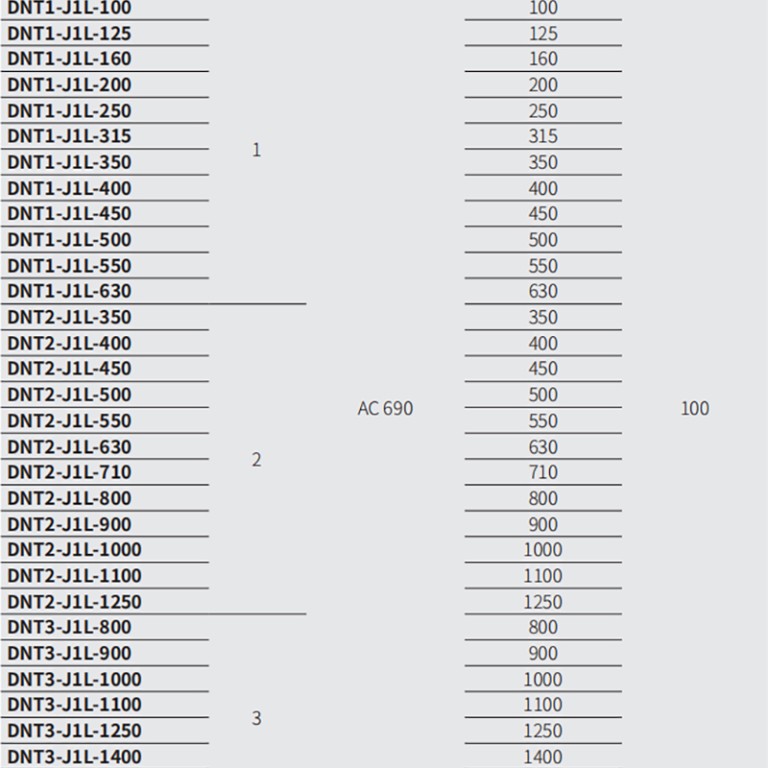Product description
DNT □ – J1L series semiconductor equipment protection fuse, suitable for AC systems,The rated voltage is 690 V, and the rated current is 100A~1600A.
It is used for short-circuit protection of semiconductor components and their complete equipment.
The performance indicators of the product comply with GB/T 13539.4/IEC 60269-4.
Basic parameters of fuse links
| Product model | size | Rated voltage V | Rated current A | Rated breaking capacity kA |
| DNT1-J1L-100 | 1 | AC 690 | 100 | 100 |
| DNT1-J1L-125 | 125 | |||
| DNT1-J1L-160 | 160 | |||
| DNT1-J1L-200 | 200 | |||
| DNT1-J1L-250 | 250 | |||
| DNT1-J1L-315 | 315 | |||
| DNT1-J1L-350 | 350 | |||
| DNT1-J1L-400 | 400 | |||
| DNT1-J1L-450 | 450 | |||
| DNT1-J1L-500 | 500 | |||
| DNT1-J1L-550 | 550 | |||
| DNT1-J1L-630 | 630 | |||
| DNT2-J1L-350 | 2 | 350 | ||
| DNT2-J1L-400 | 400 | |||
| DNT2-J1L-450 | 450 | |||
| DNT2-J1L-500 | 500 | |||
| DNT2-J1L-550 | 550 | |||
| DNT2-J1L-630 | 630 | |||
| DNT2-J1L-710 | 710 | |||
| DNT2-J1L-800 | 800 | |||
| DNT2-J1L-900 | 900 | |||
| DNT2-J1L-1000 | 1000 | |||
| DNT2-J1L-1100 | 1100 | |||
| DNT2-J1L-1250 | 1250 | |||
| DNT3-J1L-800 | 3 | 800 | ||
| DNT3-J1L-900 | 900 | |||
| DNT3-J1L-1000 | 1000 | |||
| DNT3-J1L-11003 | 1100 | |||
| DNT3-J1L-1250 | 1250 | |||
| DNT3-J1L-1400 | 1400 | |||
| DNT3-J1L-1500 | 1500 | |||
| DNT3-J1L-1600* | 1600 |
Appearance and installation dimensions

What is a semiconductor fuse?
A semiconductor fuse, also known as a high-speed fuse or a fast-acting fuse, is a specialized type of electrical fuse designed to protect sensitive semiconductor devices from overcurrent conditions. These fuses are engineered to quickly interrupt the flow of current in a circuit when a fault or overcurrent event occurs.
Here are some key characteristics and features of semiconductor fuses:
1.Fast Response Time: Semiconductor fuses are designed to react very quickly to overcurrent events. This rapid response helps protect semiconductor devices that may be sensitive to short-duration, high-current spikes.
2.Specific Current Ratings: Semiconductor fuses are rated based on their current-carrying capacity. It’s crucial to select a fuse with a current rating that matches or slightly exceeds the nominal operating current of the protected semiconductor device.
3.Voltage Ratings: The voltage rating of the fuse should be equal to or greater than the voltage of the circuit it is protecting. Using a fuse with a lower voltage rating can lead to unreliable protection.
4.Application-Specific: Semiconductor fuses are commonly used in circuits containing sensitive electronic components like diodes, transistors, thyristors, and other semiconductor devices.
5.Construction: They are typically constructed with specialized materials and designs to handle the unique characteristics of semiconductor applications.
6.Coordination with Other Protection Devices: Semiconductor fuses are often used in conjunction with other protective devices like circuit breakers to provide comprehensive protection for an electrical system.
7.Standards and Compliance: Semiconductor fuses are subject to industry standards and certifications. Ensuring that the chosen fuse complies with relevant standards is essential for safety and performance.
8.Safety and Reliability: Proper selection and application of semiconductor fuses are crucial for the safe and reliable operation of electronic and electrical systems.
Semiconductor fuses play a critical role in safeguarding semiconductor devices from potentially damaging overcurrent conditions. Choosing the right fuse, based on factors like current ratings, voltage ratings, and response time, is essential for effective protection. Consulting with a qualified electrical engineer or expert in the field is recommended for proper selection and installation of semiconductor fuses.
Semiconductor fuses find application in a variety of industries and environments where sensitive electronic components need protection from overcurrent conditions.
Here are some common application areas for semiconductor fuses:
Industrial Automation: Semiconductor fuses are used in automation systems where sensitive electronic control circuits, such as PLCs (Programmable Logic Controllers), are employed. They protect these critical components from overcurrent events that could lead to damage or malfunction.
Power Electronics: In power electronics applications, semiconductor devices like diodes, thyristors, IGBTs (Insulated Gate Bipolar Transistors), and MOSFETs (Metal-Oxide-Semiconductor Field-Effect Transistors) are used. Semiconductor fuses are crucial to safeguard these devices from short-circuit and overcurrent conditions.
Telecommunications: They are used in telecommunications equipment to protect sensitive electronic components like transistors, diodes, and integrated circuits from electrical faults.
Renewable Energy Systems: Semiconductor fuses are employed in solar inverters, wind turbine converters, and other renewable energy systems to protect the sensitive electronics from overcurrent events.
Medical Equipment: Sensitive electronic components are present in various medical devices, and semiconductor fuses are used to ensure their protection from overcurrent conditions.
Electrical Distribution Systems: In large electrical distribution systems, semiconductor fuses can be used to protect critical electronic components in switchgear, control panels, and power distribution boards.
Automotive Electronics: Modern vehicles rely on a wide range of electronic systems. Semiconductor fuses play a role in protecting these electronic components from overcurrent events.
Consumer Electronics: Semiconductor fuses can be found in various consumer electronics devices like televisions, audio equipment, and computer systems, where sensitive semiconductor devices are used.
Regarding semiconductor devices themselves, they are a crucial component of modern electronics. Semiconductors are materials with electrical properties that lie between those of conductors (like metals) and insulators (like ceramics). They have the ability to conduct electrical current under certain conditions, and their conductivity can be controlled or modulated.
Common semiconductor materials include silicon, gallium arsenide, and other compounds. Semiconductors are used in a wide range of electronic devices, including transistors, diodes, integrated circuits, and more. They form the backbone of modern electronics and are found in applications ranging from microchips in computers to power devices in electrical systems.
Click to view grl group company information>>
Click to view grl fuse link product>>
Click to view fuse base product>>
Click to view fuse holder product>>
leave your question
Get your Comfortable Solution
![]()
GRL Electric Co., Ltd. is one of the leading companies in the Middle And High End market of low-voltage electric in China






